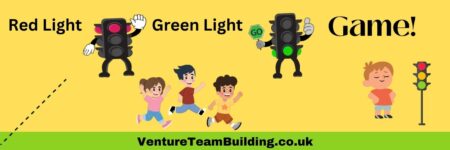If you have five minutes to spare at the end of the session (or allocated) then the 5 minute reviews below a great for everybody to have some form of input in the reviewing process. You may also want to add a few open questions to the mix but beware that with a group of ten, this still only allows only 30 seconds per person.
Fortunately, Unfortunately
The group tell the story of the last activity, taking it in turns to say just one sentence beginning with “Fortunately”…. or “Unfortunately…” Go round the circle one at a time allow passing this is called an alternative round depending on the pair of sentence beginnings you choose this can help create a balanced view of what happened.
Active Listening
While you tell the story of what happened participants show their feelings at the time. They can use head height to shows ups and downs. Moving in and out of the circle they can show how involved within the group they felt. Using facial expressions and gestures they can show any other information they like. Encourage group communication.
Landscape/Environment Metaphors
Ask the group to choose on object from the landscape/environment that they can be used to describe how they felt. This can focus on a specific element of the activity or the activity as a whole. In turn each member of the group is to share their metaphor
Pass the Rope
Tie two ends of a rope together to make a circle. Stand in a circle and pass the rope through everyone’s hands. The group decides when the rope stops. If you have the knot in your hands when the rope stops then you have to say something about the activity. You can also stipulate what kind of things they need to say (e.g. one thing that they learned, the funniest moment, someone who stood out, etc.). Try to encourage participants not to say the same thing as others.
Action Replay
Instant action replay of whole (or part of the activity in the time available. Explain that you have the remote control and will be using various buttons e.e. fast forward, rewind, pause, slow etc. If time allows take the risk and hand over the control.
The Talking Knot
Use a small length of rope and tie and simple knot (or use a ball, beanbag, whatever is to hand) as the talking tool – people are only allowed to talk if they are holding the knot. Ask open questions to encourage participants to discuss things about the session (what they learned, how they felt, their favourite moment, etc). Everyone must have the knot at least once. NOBODY can speak unless they have the knot – the knot must come back to you so that you can ask a question.
Objective Line
Each individual lays their rope on the ground. The near end represents their starting point (now) and the far end represents their goal (e.g. for the next activity, for the programme or for the transfer of learning). Ask each person to walk slowly along their line into the future towards their goal, pausing for thought in a few places along the way. Ask them to think about what would be happening at each point and how they would be feeling. Once everyone has completed their journey to their goal on their own, ask them to find a partner and talk through their anticipated journey as they walk along the line.
Comfort Zones
Lay out ropes/webbing in the shape of the comfort zone model and ask participants to place a unique object in the model to show how they felt during the challenge. This should focus on individual elements for example:
- How did you feel when you arrived at the challenge?
- How did you feel during the challenge?
- How did you feel at the end of the task?
Fish Bowl
Make a rope circle on the ground. Divide the group in two. One half sits inside the circle and may talk. One half sits outside the circle and may only observe and listen. People in the inner circle review the previous exercise. After a few minutes the half groups change places and the new inner group continue with the review or comment on the review process they have just been observing.
Traffic Lights
Hand cards out to the group and then ask a series of questions about how the group felt at key points during the activity. Participants can respond to the questions using the traffic light system and you should draw on individuals with significant response. Use red, amber and green cards.
Using Playing Cards
Cards Review 1
Distribute one or two cards to each member of the group. The suit on each card will correspond to the following:
- Diamond – Someone who has been a diamond and has shone during the activity
- Heart – Something that you loved about the activity
- Club – A time when the group had to club together
- Spade – A time when the group had to dig deep
In turn each person is to read out their response in relation to the cards they were dealt. Others in the group can contribute to the comment to provide more of a discussion format.
Cards Review 2
As before, hand out 1 or 2 cards to each member of the group. Suits of the cards relate to the following:
- Diamonds – Facts (What happened? What appeared to be going on? What did you notice? What did you not notice?)
- Hearts – Feelings (What feelings were experienced during/ after the activity? How did the group feel?)
- Spades – Findings (What have you found out? What does this mean?)
- Clubs – Future (What do you want to take forward? Are there any future opportunities for improvement?
- Red means it was hard/dangerous/made you want to stop
- Amber means it was difficult but manageable
- Green means it was safe and easy
Connecting to Last Time
Use alternating rounds to investigate questions such as “How was this like/unlike the last activity?” “In what ways did you perform better/worse as a team compared to the last activity?” To develop a positive view ask in what ways did your performance in this activity show that you have learnt something since the last one?”
The group respond with action replays, verbal responses or both.
Connecting to Next Activity
“Show me what you want to take from this experience into the next activity.” Sub groups prepare short mimes or replays. Alternatively, individuals choose objects to represent what they want to take forwards.
The majority of these 5 Minute Reviews were taken from Roger Greenaways fantastic reviewing website, for more great ideas visit: www.reviewing.co.uk



